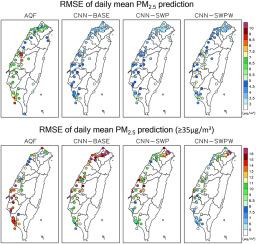Enhancing real-time PM2.5 forecasts: A hybrid approach of WRF-CMAQ model and CNN algorithm
IF 3.7
2区 环境科学与生态学
Q2 ENVIRONMENTAL SCIENCES
引用次数: 0
Abstract
As fine particulate matter (PM2.5) poses significant environmental and human health risks, there is an urgent need for accurate forecasting systems. In Taiwan, the current air quality forecasting (AQF) system based on the Weather Research and Forecasting meteorological model and Community Multiscale Air Quality model provides essential predictions but is limited by biases and computational complexities. This study introduces a convolutional neural network (CNN)-based PM2.5 forecasting model to enhance prediction accuracy. The CNN model incorporates hourly PM2.5 concentrations from surface observations and the AQF system, along with synoptic weather patterns (SWPs), to predict PM2.5 levels up to 72 h in advance. Three CNN models were developed: CNN-BASE (without SWPs), CNN-SWP (with SWPs), and CNN-SWPW (with SWPs and a weighted loss function). Performance assessment reveals a significant reduction in the mean RMSE of 72-h PM2.5 prediction, from 10.48 μg/m3 with the AQF system to 6.88 μg/m3 with the CNN-BASE model. However, CNN-BASE showed the lowest prediction accuracy for high PM2.5 concentrations (only 26.2%) due to a small subset of samples. Including SWPs improves the model's ability to capture meteorological influences, enhancing predictions of high PM2.5 concentrations. Furthermore, CNN-SWPW incorporates a weighted loss function to address imbalanced sample size distributions, further enhancing the accuracy of high PM2.5 predictions. This study demonstrates the potential of CNNs in operational air quality forecasting.

加强 PM2.5 实时预测:WRF-CMAQ 模型和 CNN 算法的混合方法
由于细颗粒物(PM2.5)对环境和人类健康构成重大风险,因此迫切需要精确的预报系统。在台湾,目前基于气象研究与预报气象模型和社区多尺度空气质量模型的空气质量预报(AQF)系统可提供基本预测,但受到偏差和计算复杂性的限制。本研究引入了基于卷积神经网络(CNN)的 PM2.5 预测模型,以提高预测精度。卷积神经网络模型结合了地面观测和空气质量框架系统的每小时 PM2.5 浓度以及天气同步模式(SWPs),可提前 72 小时预测 PM2.5 水平。开发了三种 CNN 模型:CNN-BASE(不含 SWPs)、CNN-SWP(含 SWPs)和 CNN-SWPW(含 SWPs 和加权损失函数)。性能评估显示,72 小时 PM2.5 预测的平均均方根误差大幅降低,从 AQF 系统的 10.48 μg/m3 降至 CNN-BASE 模型的 6.88 μg/m3。不过,由于样本子集较小,CNN-BASE 对 PM2.5 高浓度的预测准确率最低(仅为 26.2%)。加入 SWPs 提高了模型捕捉气象影响的能力,从而增强了对 PM2.5 高浓度的预测。此外,CNN-SWPW 纳入了加权损失函数,以解决样本量分布不平衡的问题,进一步提高了 PM2.5 高浓度预测的准确性。这项研究证明了 CNN 在业务空气质量预测方面的潜力。
本文章由计算机程序翻译,如有差异,请以英文原文为准。
求助全文
约1分钟内获得全文
求助全文
来源期刊

Atmospheric Environment
环境科学-环境科学
CiteScore
9.40
自引率
8.00%
发文量
458
审稿时长
53 days
期刊介绍:
Atmospheric Environment has an open access mirror journal Atmospheric Environment: X, sharing the same aims and scope, editorial team, submission system and rigorous peer review.
Atmospheric Environment is the international journal for scientists in different disciplines related to atmospheric composition and its impacts. The journal publishes scientific articles with atmospheric relevance of emissions and depositions of gaseous and particulate compounds, chemical processes and physical effects in the atmosphere, as well as impacts of the changing atmospheric composition on human health, air quality, climate change, and ecosystems.
 求助内容:
求助内容: 应助结果提醒方式:
应助结果提醒方式:


